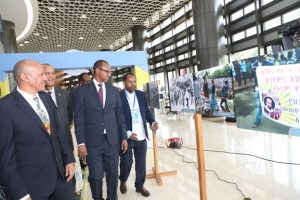
BY HAILE DEMEKE
ADDIS ABABA – The sustained participation of the Diaspora community coupled with meticulous research is crucial in clarifying and succeeding in the construction of the Abbay Dam, which is a national symbol, according to an expert in the area.
Vice President and Academic Research at Florida University and Research Fellow at the Nile House Dereje Befekadu (PhD) launched a book titled “Demystifying the Nile, History and Events Leading to the Realization of the GERD.’ The book consists of a six-part summary of the events that started thousands of years ago culminating in the construction of the grand dam.
The book has also covered the researcher’s trip from the two sources of the Nile River such as the Gish Abay of Ethiopia and Jinja Uganda to the mouth of the Mediterranean Sea.
The academician said in his book that, Ethiopians waited for thousands of years to use their resources in the Nile River. “The seeds know how to wait and most seeds wait for several years before starting to grow. There are mounting pressures being exerted on the country to thwart the construction of the project.”
Ethiopians had to wait over a thousand years to be able to use their water for development. Ethiopian leaders have tried their best to build a dam on the Nile River as part of their development effort. Unfortunately due to varying reasons and circumstances including external pressure, geo and hydro-political balance shifts and others they were not successful.
Following the decade-long negotiation and agreement on the equitable use of the Nile waters by most riparian countries and the subsequent Cooperative Framework Agreement, the Ethiopian government started the construction of the Abay Dam in 2011.
“The waiting had finally ended and it was time for the seed to grow. Unfortunately, external pressure persisted blocking all access to international funding causing the country to proceed using its means.”
“Almost 12 years later, the construction program is almost done. The reservoir already has billions of cubic meters of water. The seed has sprouted, and the tree is on track to be the tallest in Africa. At the same time, the international pressure on Ethiopia has intensified.”
History is repeating itself what had happened to Egypt in the 1950s is now happening to Ethiopia. The same countries that are now threatening Ethiopia with sanctions had at that time denied President Nasser international loans for his quest to build the Aswan High Dam, forcing him to take drastic measures including nationalizing the Suez Canal to pay for the construction.
On the other hand, the participation of the Diaspora community is said to be crucial to accomplish the national project and it needs strong connection between the concerned stakeholders.
Foreign Affairs State Minister Tesfaye Yilma (Ambassador) said that, the book is vital in the recognition of the international community by the Ethiopian researcher and it is rich in the facts of the river.
For his part, Ethiopian Ambassador to the U.S. Seleshi Bekele (Eng. PhD) said Egypt has been using coercive ways to use the resources alone in which Ethiopia contributes the lion’s share. On the other hand, Ethiopia is fully adhered to the international rule of equitable and reasonable utilization of trans-boundary water.
THE ETHIOPIAN HERALD TUESDAY 10 JANUARY 2023





